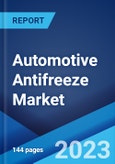Automotive antifreeze is a colored liquid that is used as an additive along with water to maintain the temperature of the internal combustion engine (ICE). Ethylene glycol, propylene glycol, and glycerin are some commonly used automotive antifreeze fluids. They are produced through organic acid technology (OAT), inorganic additive technology (IAT), and hybrid organic acid technology (HOAT). Automotive antifreeze is widely used to regulate the engine during extreme weather conditions and protect it from corrosion. It acts by lowering the water’s freezing point and raising its boiling point, which, in turn, protects the engine from extensive damage, explosion, and overheating.
Automotive Antifreeze Market Trends:
The market is primarily being driven by significant growth in the automotive industry. Automotive antifreeze is widely used in passenger and commercial vehicles to maintain optimum fuel economy, reduce maintenance costs, prevent breakdowns, rust, and electrolysis, and extend the life of rubber and plastic components. Furthermore, the widespread utilization of heavy-duty antifreeze in construction equipment, such as bulldozers, excavators, harvesters, trenchers, and forklifts, is providing a considerable boost to market growth. Additionally, the introduction of environmental-friendly and bio-based antifreeze, such as glycerin that can be produced from corn, stover, and other oil-rich sources, is providing an impetus to market growth.Moreover, the rising demand for high-quality, technologically advanced additive supplements in antifreeze to improve the health and longevity of diesel engines by inhibiting corrosion and cavitation is creating a positive outlook for the market. Other factors, including the implementation of various government initiatives promoting the use of high-performance lubricants to reduce carbon footprints and extensive research and development (R&D) activities to engineer cost-effective and non-toxic product variants with extended life, are anticipated to drive the market toward growth.
Key Market Segmentation:
The publisher provides an analysis of the key trends in each sub-segment of the global automotive antifreeze market report, along with forecasts at the global, regional and country levels from 2024-2032. Our report has categorized the market based on fluid type, technology, vehicle type and distribution channel.Breakup by Fluid Type:
- Ethylene Glycol
- Propylene Glycol
- Glycerine
Breakup by Technology:
- Inorganic Additive Technology (IAT)
- Organic Acid Technology (OAT)
- Hybrid Organic Acid Technology (HOAT)
Breakup by Vehicle Type:
- Passenger Vehicle
- Commercial Vehicle
- Construction Vehicle
Breakup by Distribution Channel:
- Original Equipment Manufacturers (OEMs)
- Aftermarket
Breakup by Region:
- North America
- United States
- Canada
- Asia-Pacific
- China
- Japan
- India
- South Korea
- Australia
- Indonesia
- Others
- Europe
- Germany
- France
- United Kingdom
- Italy
- Spain
- Russia
- Others
- Latin America
- Brazil
- Mexico
- Others
- Middle East and Africa
Competitive Landscape:
The competitive landscape of the industry has also been examined along with the profiles of the key players being AMSOIL Inc., BP p.l.c., Chevron Corporation, Cummins Inc., ExxonMobil Corporation, Fuchs Petrolub SE, Halfords Group PLC, Motul S.A, Prestone Products Corporation, Recochem Inc., Shell plc, TotalEnergies SE, Valvoline Inc. and VOLTRONIC GmbH.Key Questions Answered in This Report
1. What was the size of the global automotive antifreeze market in 2023?2. What is the expected growth rate of the global automotive antifreeze market during 2024-2032?
3. What has been the impact of COVID-19 on the global automotive antifreeze market?
4. What are the key factors driving the global automotive antifreeze market?
5. What is the breakup of the global automotive antifreeze market based on the fluid type?
6. What is the breakup of the global automotive antifreeze market based on the technology?
7. What is the breakup of the global automotive antifreeze market based on the vehicle type?
8. What is the breakup of the global automotive antifreeze market based on the distribution channel?
9. What are the key regions in the global automotive antifreeze market?
10. Who are the key players/companies in the global automotive antifreeze market?
Table of Contents
Companies Mentioned
- AMSOIL Inc.
- BP p.l.c.
- Chevron Corporation
- Cummins Inc.
- ExxonMobil Corporation
- Fuchs Petrolub SE
- Halfords Group PLC
- Motul S.A
- Prestone Products Corporation
- Recochem Inc.
- Shell plc
- TotalEnergies SE
- Valvoline Inc.
- VOLTRONIC GmbH
Methodology

LOADING...
Table Information
| Report Attribute | Details |
|---|---|
| No. of Pages | 144 |
| Published | August 2024 |
| Forecast Period | 2023 - 2032 |
| Estimated Market Value ( USD | $ 4.2 Billion |
| Forecasted Market Value ( USD | $ 6.3 Billion |
| Compound Annual Growth Rate | 4.6% |
| Regions Covered | Global |
| No. of Companies Mentioned | 14 |









